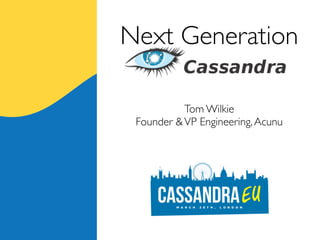Next Generation Cassandra
- 1. Next Generation Cassandra Tom Wilkie Founder & VP Engineering, Acunu
- 3. Cassandra needs a team âĒ Installing, conïŽguring and deploying âĒ Automating management operations âĒ Monitoring and alerting $ $ $ $ âĒ Testing and ïŽxing bugs âĒ Tuning the garbage collector âĒ Tweaking the storage engine 3
- 4. Acunu: your enterprise Cassandra Appliance Data driven applications Web UI Apache Cassandra Control Center Acunu Storage Engine ConïŽgured and tuned OS Commodity Hardware 4
- 5. Storage Engine aka Castle
- 6. Castle: Built for Big Data âĒ Storage engine optimized for large slow disks, many cores, Big Data workloads âĒ Enterprise density on commodity hardware âĒ Lightning disk rebuilds:10x faster than RAID Shared memory interface Castle keys Userspace Acunu Kernel userspace interface values In-kernel async, shared memory ring workloads shared buffers kernelspace Streaming interface interface range key buffered key buffered queries insert value insert get value get Doubling Arrays âĒ Opensource (GPLv2, MIT doubling array mapping layer for user libraries) insert Bloom ïŽlters queues key get arrays x range arrays queries management http://goo.gl/gzihe key âĒ insert merges http://bitbucket.org/acunu Arrays mapping layer âĒ modlist btree key Version tree Loadable Kernel Module, insert btree key get btree targeting CentOSâs 2.6.18 range queries value arrays 6 âĒ Cache apping & http://www.acunu.com/ ng layer "Extent" layer prefetc extent block extent cache
- 8. Rebuild time 5 4 Rebuild Time (Hours) 3 2 1 0 RAID10, 8 Disks RAID5, 8 Disks RDA, 8 Disks RDA, 15 Disks 8
- 10. Control Center The new UI has been critical in helping us work out what is wrong in our code âThe new UI has been critical in helping us work out what is wrong in our codeâ - Matt Miller, TellyBug
- 11. Breaking System
- 12. 13,000 tests per day 1.1 million tests per release 3.5k machine days of testing for each release 12
- 13. Short, unit tests Distributed tests Data integrity tests Tests for common, long running operations (bootstrap, decommission, backup, restore etc) Failure simulation Resource usage tests (checking memory and cpu consumption) Long running performance tests 13
- 18. âTurnkey Cassandraâ No need to master the internals No tuning required No need for a committer on staff


















